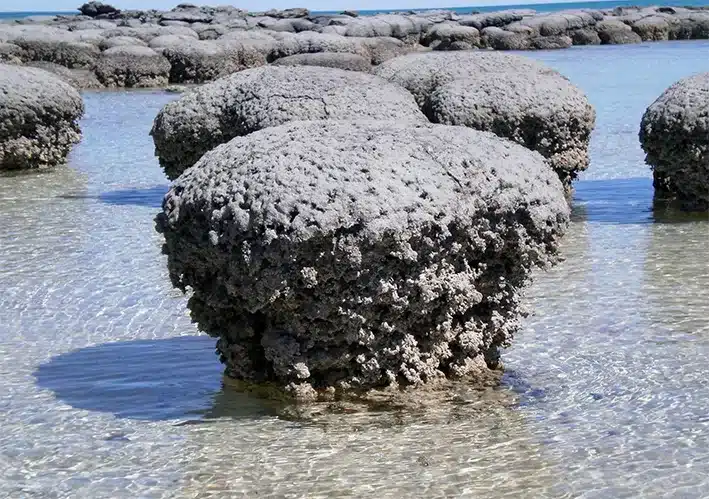Stromatolite fossils
Stromatolite fossils
What is a stromatolite?
The term “stromatolite” comes from the Greek words στρῶμα (strōma) and λίθος (lithos), meaning “layer” and “rock” respectively. Essentially, stromatolites are layered sedimentary rocks primarily shaped by microbial organisms, often exhibiting convex-up layers.
However, similar structures can be formed by animals like sponges, stromatoporoids, bryozoans, and algae, causing confusion in defining stromatolites. In ancient geologic eras like the Archean and Proterozoic, stromatolites included abiogenic sparry crusts as common components, sometimes alternating with biogenic layers. This complexity raises challenges in precisely defining stromatolites.
Stromatolites, as trace fossils, document the interplay between microbial communities and sediments. Examining their microscopic details provides insights into ecological gradients and pathways, while the macroscopic shape may indicate significant environmental influences. Analyzing scalar attributes allows for a better understanding of microbial behavior, contributing to biostratigraphic and facies analysis spanning the last 3500 million years.
Stromatolites, microbial laminated benthic deposits, result from sediment trapping, binding, and bio-induced mineral precipitation. Their existence dates back approximately 3.5 billion years, marking them as Earth’s earliest life forms. Modern stromatolites, formed by organisms like cyanobacteria, reflect the likely composition of ancient counterparts. Despite not being body fossils, stromatolites may contain calcified microbe fossils.
Categorized as microbialites, stromatolite falls into four types based on mesostructure: laminated (stromatolite), clotted (thrombolite), dendritically clotted (dendrolite), and aphanitic (leiolite).
Stromatolite-forming cyanobacteria played a crucial role in Earth’s early atmosphere by producing oxygen through photosynthesis. Flourishing through the Proterozoic era, stromatolites declined in the Neoproterozoic due to decreasing atmospheric pCO2 and temperatures, affecting seawater carbonate saturation and cyanobacterial calcification. The Phanerozoic stromatolite record fluctuates, influenced by factors such as animal abundance, seawater chemistry, and temperature.
What is the fossil stromatolite?
A stromatolite is a rocky structure formed by slimy microorganisms that build layers over time. These organisms, like cyanobacteria, create thin layers that can be seen with the naked eye. Some people use the term “stromatolite” for ancient rock formations and call their modern counterparts “microbial mats.”
Others only call structures stromatolites if they stick up a lot, while flat ones are called mats or sheets. But what’s important in all these definitions is that the layering in stromatolites comes from living things—the term is only used for structures that are known or believed to be made by living organisms.
Most stromatolites are made of calcium carbonate and don’t have clear remains of the microbes that built them. The organic cells get squished between the growing carbonate grains during the rock-forming process. So, just like footprints or trails left in ancient sediment, stromatolites are considered trace fossils. They show evidence of biological activity but aren’t the fossilized organisms themselves.

